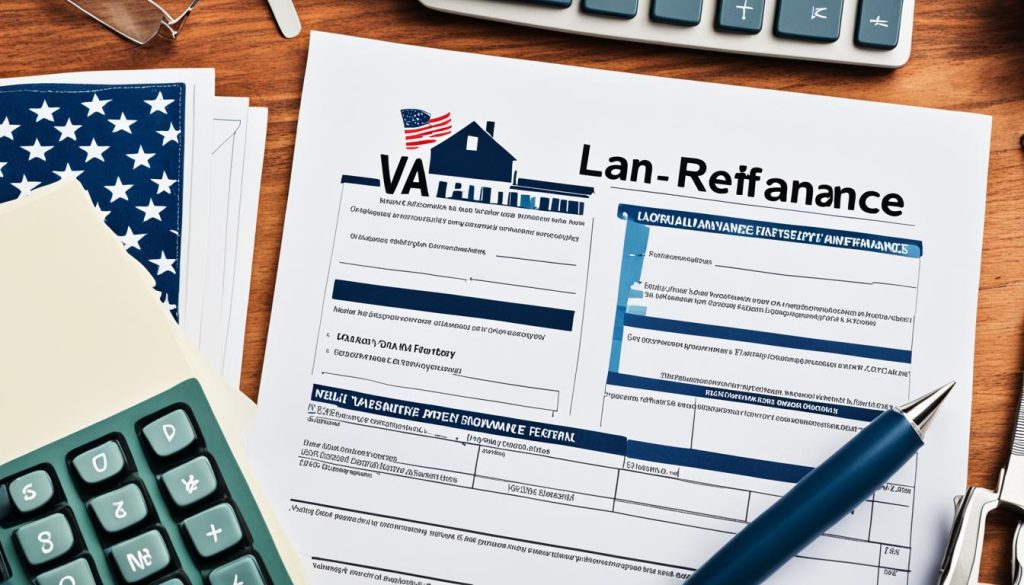Refinancing your mortgage can be a smart financial move, especially if you have fair credit. By exploring the various refinancing options available, you can take advantage of lower interest rates, reduce your monthly payments, and improve your overall financial health. In this article, we’ll discuss the different types of refinance loans that you can consider with fair credit, so you can make an informed decision that aligns with your goals and needs.
If you have fair credit and are looking to refinance your mortgage, it’s important to know that you have options. While it may be more challenging to qualify for certain types of refinancing with fair credit, it’s not impossible. Lenders understand that credit scores are just one aspect of an individual’s financial profile, and they consider other factors such as income, employment history, and debt-to-income ratio.
Key Takeaways:
- Refinancing your mortgage with fair credit is possible and can provide numerous benefits.
- Explore different refinance options to find the best fit for your financial goals and needs.
- Consider factors beyond your credit score, such as income, employment history, and debt-to-income ratio.
- Shop around and compare offers from multiple lenders to ensure you get the best terms and rates.
- Refinancing can be a crucial step towards improving your overall financial health.
Rate-and-Term Refinance: Lower Your Monthly Payments or Pay off Your Mortgage Faster.
A rate-and-term refinance is a flexible solution that allows you to modify the interest rate and terms of your existing mortgage. By doing so, you can achieve either lower monthly payments or a faster repayment of your mortgage. This type of refinance is particularly beneficial if you have seen a decrease in interest rates since you closed on your original mortgage or if your credit has improved. Let’s dive deeper into how a rate-and-term refinance can help you achieve your financial goals.
If your objective is to lower your monthly payments, a rate-and-term refinance offers two options. First, you can choose a longer repayment period, which spreads out the total amount you owe over a greater number of months. This can result in a reduction of your monthly payment amount. Second, you can take advantage of a lower interest rate. By refinancing your mortgage at a lower rate, your monthly payment will decrease, allowing you to allocate more of your income towards other financial priorities.
On the other hand, if your aim is to pay off your mortgage faster, a rate-and-term refinance can help you achieve that goal as well. You can choose a more condensed repayment term, which reduces the number of years it takes to fully repay your mortgage. This means you’ll be able to own your home outright sooner and save money on interest costs over the lifetime of your loan.
Keep in mind that the decision to pursue a rate-and-term refinance depends on several factors, including your current interest rate, credit score, and financial goals. It’s essential to evaluate the potential savings and assess whether the benefits outweigh the costs associated with refinancing.
Benefits of Rate-and-Term Refinance:
- Lower monthly payments through longer repayment periods or reduced interest rates
- Accelerate mortgage payoff by choosing a condensed repayment term
- Potential savings on interest costs over the life of the loan
- Opportunity to leverage improved credit or decreased interest rates
Considerations for Rate-and-Term Refinance:
- Assess the costs and fees associated with refinancing
- Evaluate the potential savings and break-even point
- Compare offers from multiple lenders to secure the best terms and rates
- Consult with a financial advisor to ensure the refinance aligns with your long-term financial goals
By carefully considering a rate-and-term refinance, you can take control of your mortgage and optimize your financial situation. Whether you’re looking to reduce your monthly payments or pay off your mortgage faster, this type of refinance offers the flexibility to achieve your desired outcome.
| Benefits | Considerations |
|---|---|
| Lower monthly payments | Assess costs and fees |
| Faster mortgage payoff | Evaluate potential savings |
| Saving on interest costs | Compare offers from multiple lenders |
| Opportunity for improved credit | Consult with a financial advisor |
Cash-Out Refinance: Access Your Home Equity for Other Expenses.
A cash-out refinance provides homeowners with the opportunity to access the equity in their property and use it to finance various expenses. This type of refinance allows you to take out a new mortgage loan for more than the amount owed on your current mortgage, and the extra funds can be used for a wide range of purposes.
One of the most common reasons homeowners choose a cash-out refinance is to fund home improvements or a renovation project. Whether you want to upgrade your kitchen, add an additional room, or enhance your outdoor living space, a cash-out refinance can provide the necessary funds to turn your vision into a reality.
“A cash-out refinance can give you the financial flexibility to complete the home improvements you’ve been dreaming of.”
By accessing the equity in your home through a cash-out refinance, you can benefit from potentially lower interest rates compared to other types of loans or credit options. This can result in significant savings over time, especially if you are consolidating higher-interest debts to take advantage of the lower mortgage rates.
It’s important to remember that eligibility for a cash-out refinance will depend on meeting your lender’s credit and debt-to-income ratio requirements. Additionally, you’ll need to have a certain amount of equity in your home to qualify for this type of refinance. The exact requirements may vary, so it’s essential to consult with your lender to determine if a cash-out refinance is the right option for you and to explore your specific eligibility criteria.
Why Choose a Cash-Out Refinance for Your Home Improvement or Renovation Project?
There are several reasons why a cash-out refinance can be an excellent choice for financing your home improvement or renovation project:
- Lower Interest Rates: Cash-out refinancing often offers lower interest rates compared to alternative financing options, such as personal loans or credit cards. This can result in significant savings over time and make your home improvement project more affordable.
- Tax Deductibility: The interest paid on a cash-out refinance is generally tax-deductible, unlike interest on personal loans or credit cards. Consult with a tax professional to understand how the tax benefits of a cash-out refinance may apply to your specific situation.
- Consolidation of Higher-Interest Debts: If you have outstanding debts with higher interest rates, such as credit cards or personal loans, cash-out refinancing can provide a way to consolidate these debts into a single, more manageable payment.
Considering these benefits, a cash-out refinance can be a smart choice when it comes to financing your home improvement or renovation project. It allows you to leverage the equity in your property to achieve your goals while potentially saving money on interest.
At the same time, it’s important to carefully evaluate your financial situation and consider factors like closing costs and potential changes to your monthly mortgage payment. Consulting with a mortgage professional can help you make an informed decision based on your unique circumstances.
Ready to access your home equity for other expenses? Consult with a lender or mortgage professional to explore your cash-out refinance options today.
Cash-In Refinance: Reduce Your Monthly Payments and Increase Your Home Equity.
A cash-in refinance is a strategic financial move that can help you reduce your monthly mortgage payments, lower interest costs, and increase your home equity. By putting a lump sum payment towards your existing mortgage balance at closing, you can decrease your loan-to-value ratio and gain more ownership of your home.
If you are a homeowner who is underwater on your mortgage or lacks equity in your home, a cash-in refinance can be particularly beneficial. Not only can it improve your financial situation by increasing your home equity, but it can also help you qualify for better loan terms, such as a lower interest rate.
Reducing Monthly Payments
One of the primary benefits of a cash-in refinance is the ability to reduce your monthly mortgage payments. By decreasing your loan amount through an upfront payment, you can lower the principal balance and subsequently pay less each month. This can provide significant relief for your budget and increase your overall financial stability.
Lowering Interest Costs
Another advantage of a cash-in refinance is the potential to lower your interest costs. By reducing your loan-to-value ratio, you present less risk to lenders, which may result in a lower interest rate on your refinanced mortgage. Over the course of your loan term, this can lead to substantial savings and allow you to pay off your mortgage faster.
Increasing Home Equity
A cash-in refinance is an effective way to increase your home equity. By injecting additional funds into your mortgage, you build more ownership in your property and gain access to increased equity. This can be particularly valuable if you plan to sell your home in the future or use your home equity for other financial objectives, such as funding home improvements or consolidating debt.
Qualifying for a cash-in refinance typically requires good credit and enough cash to make the transaction worthwhile for the lender. It’s essential to carefully consider your financial situation and goals before proceeding with a cash-in refinance. Consulting with a mortgage professional can help you determine if this option aligns with your needs and provide guidance throughout the refinancing process.
Next, let’s explore another type of mortgage refinance option: FHA Streamline Refinance.
FHA Streamline Refinance: Simplified Refinancing for FHA-Insured Mortgages.
If you have an existing mortgage insured by the Federal Housing Administration (FHA), you can take advantage of the FHA Streamline Refinance program to simplify your refinancing process. This program is designed to make refinancing easier and more affordable for FHA-insured mortgage borrowers.
With an FHA Streamline Refinance, you have the opportunity to lower your monthly mortgage payments and eliminate mortgage insurance premiums. Here’s how it works:
- Lower Monthly Payments: One of the main benefits of an FHA Streamline Refinance is the ability to lower your monthly mortgage payments. You can achieve this by reducing your interest rate or transitioning from an adjustable rate to a fixed rate.
- Eliminate Mortgage Insurance Premiums: Another advantage of an FHA Streamline Refinance is the opportunity to eliminate costly mortgage insurance premiums. By refinancing your FHA-insured mortgage, you can potentially save a significant amount of money over the life of your loan.
The FHA Streamline Refinance program also offers benefits in terms of credit documentation and underwriting requirements. Typically, these requirements are less stringent compared to other refinancing options, making it easier to qualify for the program.
With the FHA Streamline Refinance, you can take control of your financial situation and potentially save money in the long run. It provides a simplified process for FHA-insured mortgage borrowers who want to lower their monthly payments and eliminate mortgage insurance premiums.
“The FHA Streamline Refinance program offers FHA-insured mortgage borrowers the opportunity to lower their monthly payments and eliminate mortgage insurance premiums.”
Consider taking advantage of the FHA Streamline Refinance program if you have an existing FHA-insured mortgage. By exploring this option, you can potentially reduce your financial burden and achieve greater stability in your homeownership journey.
Pros and Cons of FHA Streamline Refinance
| Pros | Cons |
|---|---|
| Lower monthly payments | May not be available for non-FHA mortgages |
| Eliminate mortgage insurance premiums | May not be suitable for significant interest rate reductions |
| Simplified credit documentation and underwriting requirements | Must meet specific eligibility criteria |
VA Streamline Refinance: Streamlined Refinancing for VA-Backed Mortgages.
Veterans, active-duty service members, and eligible family members with an existing home loan backed by the U.S. Department of Veteran Affairs (VA) may qualify for a VA streamline refinance. This type of refinance allows you to lower your monthly mortgage payment by reducing your interest rate or transitioning from an adjustable rate to a fixed rate. While there may be some fees involved, such as a one-time VA funding fee, a VA streamline refinance can provide financial benefits for eligible borrowers.

To help you understand the potential impact of a VA streamline refinance, consider the following example:
| Current Mortgage | Refinanced Mortgage | |
|---|---|---|
| Interest Rate | 4.5% | 3.75% |
| Loan Balance | $200,000 | $200,000 |
| Monthly Payment | $1,013.37 | $926.23 |
| Total Interest Paid | $164,616.75 | $133,642.60 |
In this example, a VA streamline refinance reduces the interest rate from 4.5% to 3.75%, resulting in a lower monthly payment of $926.23 compared to the current payment of $1,013.37. Over the life of the loan, the borrower would save approximately $30,974.15 in interest payments.
Benefits of a VA Streamline Refinance
- Lower monthly mortgage payment
- Reduced interest rate
- Streamlined approval process
- No income or asset documentation required
- No appraisal necessary in some cases
- Flexible credit requirements
By taking advantage of a VA streamline refinance, eligible borrowers can enjoy the financial benefits of lower monthly mortgage payments and reduced interest rates. As a result, they have more disposable income to allocate towards other financial goals or expenses.
With a VA streamline refinance, veterans and active-duty service members can optimize their mortgage terms and free up cash for other important needs.
USDA Streamlined Assist Refinance: Low- or No-Equity Refinancing for USDA Borrowers.
USDA streamline assist refinance loans are designed specifically for current USDA borrowers who are looking to access low- or no-equity refinancing options. This program offers more favorable repayment terms, making it affordable and advantageous for eligible homeowners. To take advantage of a USDA streamlined assist refinance, borrowers must work with a USDA-approved lender. Notably, the program typically does not require an appraisal, credit review, home inspection, or calculation of debt ratios. However, it’s important to keep in mind that cash-out refinances are not permitted under USDA home loans.
If you are a USDA borrower and are interested in refinancing your mortgage under the USDA streamlined assist refinance program, it is essential to connect with a qualified lender to explore your options.
To give you a clearer understanding of the benefits and requirements associated with the USDA streamlined assist refinance, below is a table summarizing the key features:
| Loan Program | Favorable Repayment Terms | No Appraisal Required |
|---|---|---|
| USDA Streamlined Assist Refinance | Offers more affordable and advantageous repayment terms | Does not typically require an appraisal |
This table highlights the advantages of the USDA streamlined assist refinance, such as the opportunity to access more favorable repayment terms and the convenience of not needing to undergo an appraisal. By choosing this refinancing option, USDA borrowers can potentially save time and money while improving their financial situation.
No-Closing-Cost Refinance: Minimize Upfront Costs and Free Up Cash.
A no-closing-cost refinance is an excellent option for borrowers looking to reduce upfront expenses and access additional cash. Unlike traditional refinancing, this type of refinance allows you to avoid paying any upfront closing costs. Instead, these costs are either rolled into the principal balance of the loan or translated into a slightly higher interest rate. While the interest rate might be slightly higher, the benefits of a no-closing-cost refinance can help free up cash for other expenses.
By choosing a no-closing-cost refinance, you can minimize the financial burden of paying upfront closing costs, which can include fees for the appraisal, attorney, title search, and more. Instead, these costs are gradually spread across your future mortgage payments, allowing you to allocate your cash towards other essential expenses. This option is particularly beneficial if you’re planning to sell your home within the next few years and won’t be able to recoup the closing costs.
Benefits of a No-Closing-Cost Refinance
- Minimize upfront costs: Avoid paying for appraisal, attorney, and other closing costs.
- Free up cash: Use the money you would have spent on closing costs for other financial needs or investments.
- Simplified process: Streamline the refinancing process without the need to gather additional funds for closing costs.
- Potential time and cost savings: If you plan to sell your home in the near future, a no-closing-cost refinance can help you save money on upfront expenses.
It’s important to note that while a no-closing-cost refinance can be advantageous, borrowers should consider the tradeoff of a higher interest rate or a slightly larger loan balance. Make sure to carefully evaluate the terms of the loan and calculate the long-term costs to determine if this option aligns with your financial goals.
| Pros | Cons |
|---|---|
|
|
Conclusion
Refinancing your mortgage with fair credit provides you with a range of options that can significantly improve your financial health. By exploring these options and carefully considering your specific goals and financial situation, you can make an informed decision that aligns with your needs.
Lowering your interest rates, reducing your monthly payments, and increasing your home equity are just some of the benefits that refinancing can offer. To make sure you’re getting the best refinance terms and rates, it’s crucial to shop around and compare offers from multiple lenders.
Remember, taking the time to refinance with fair credit is a vital step towards enhancing your overall financial well-being. So, don’t hesitate to explore the various refinance options available to you and make a move that can positively impact your future.
FAQ
What is a rate-and-term refinance?
A rate-and-term refinance allows you to change the interest rate and terms of your existing mortgage. This can result in lower monthly payments if you opt for a longer repayment period or a lower interest rate. It can also be used to pay off your mortgage faster by choosing a more condensed repayment term.
What is a cash-out refinance?
A cash-out refinance allows you to access the equity in your property and use it to finance various expenses. With a cash-out refinance, you take out a new mortgage loan for more than the amount owed on your current mortgage, and the extra funds can be used for home improvements, a renovation project, or other financial needs.
What is a cash-in refinance?
A cash-in refinance allows you to put a lump sum payment toward your existing mortgage balance at closing, reducing your loan-to-value ratio and increasing the equity in your home. This can help you qualify for better loan terms and potentially lower interest costs. Cash-in refinancing is particularly beneficial for homeowners who are underwater on their mortgage or lack equity in their home.
What is an FHA streamline refinance?
An FHA streamline refinance is a type of refinance available to those with an existing mortgage insured by the Federal Housing Administration (FHA). It allows you to lower your monthly mortgage payments by reducing your interest rate or transitioning from an adjustable rate to a fixed rate. Additionally, an FHA streamline refinance can help you eliminate costly mortgage insurance premiums.
What is a VA streamline refinance?
A VA streamline refinance is a type of refinance available to veterans, active-duty service members, and eligible family members with an existing home loan backed by the U.S. Department of Veterans Affairs (VA). It allows you to lower your monthly mortgage payment by reducing your interest rate or transitioning from an adjustable rate to a fixed rate. Some fees, such as a one-time VA funding fee, may apply.
What is a USDA streamlined assist refinance?
A USDA streamlined assist refinance is a type of refinance designed specifically for current USDA borrowers who wish to access low- or no-equity refinancing. It offers more favorable and affordable repayment terms. To qualify, you will need to go through a USDA-approved lender. This program typically does not require an appraisal, credit review, home inspection, or calculation of debt ratios.
What is a no-closing-cost refinance?
A no-closing-cost refinance allows borrowers to avoid paying any upfront closing costs. Instead, these fees are either rolled into the principal balance of the loan or translated into a higher interest rate. This type of refinance can help you free up cash to cover other expenses while spreading the costs of refinancing across your future mortgage payments.
Is it possible to refinance with fair credit?
Yes, it is possible to refinance with fair credit. There are several refinance options available for those with fair credit scores. By exploring these options and comparing offers from multiple lenders, you can find the best refinance terms and rates that suit your specific financial situation and goals.



